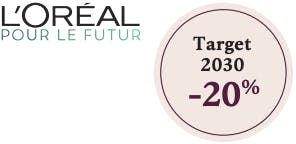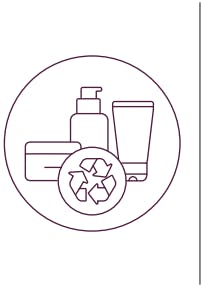Weight and volume reduction: optimising resources used

In 2021, the Group reduced by 3% in intensity the quantity of packaging used for its products, compared to 2019.

The reduction of the weight and volume of product packaging, an integral part of the design, is a major driver for improving their environmental profile. Every year, L’Oréal launches new initiatives aimed at reducing the quantity of materials used in packaging.
A continuous process is in place to reduce the weight of existing products. As an illustration, two initiatives implemented in 2021 can be mentioned:
- Lancôme redesigned its Génifique eye care by reducing the weight of the jars by 7% for a savings of 37.5 tonnes of glass; and
- the launch of a new line of solid shampoos by Garnier allows the consumer to choose to avoid plastic bottles in favour of an FSC biobased cardboard box (one solid shampoo with a cardboard box is equivalent to two plastic bottles avoided).
In addition, in order to reduce the resources intended for packaging, L’Oréal is increasingly marketing reusable products, i.e. reloadable or refillable systems, with Valentino, for example, which launched its first refillable makeup line, and L’Oréal Paris, which launched shampoo pouches to be used to refill the original bottle.
To limit packaging cubic volumes for its finished products, L’Oréal has established its own procedures for reduction at source. L’Oréal’s requirements are respectful of local regulations, and even exceed the regulations of most countries.
To optimise the flow of components, L’Oréal has developed wall-to-wall(1) production to reduce the environmental impact.
Replace: new sources of materials

In 2021, 21% of the plastic packaging materials were from recycled or biobased sources.

Aware that using non-renewable resources will not last forever, the Group seeks to replace them with recycled or biomass materials, or materials generated by technology that is not reliant on fossil-based resources. In 2021, L’Oréal used 159,351 tonnes of plastic in its primary, secondary and tertiary packaging. L’Oréal is committed to using non-fossil sources for 50% of its plastics by 2025, with an initial target of 40% for PET(2) plastic in 2020. This target has been exceeded as, since 2020,more than 50% of the PET used by the Group worldwide has been recycled PET.
Moreover, in the context of L’Oréal for the Future, the Group is aiming at reaching 100% non-fossil plastic by 2030.
Several brands use recycled plastic (some as much as 100%) or recycled glass in their bottles: 73,707 tonnes of recycled materials(3), including 43,373 tonnes in primary and secondary packaging, saved the equivalent amount of virgin materials in 2021. 67.1%, or 26,073 tonnes, of the volume of PET used by the Group worldwide is recycled PET.
(1) Since 2010, the Group has implemented wall-to-wall production, which consists of setting up, within its factories, a production unit for packaging operated by a supplier. This partnership makes it possible to develop reactivity and manufacturing flexibility, while reducing the transportation of packaging and generation of waste related to its production.
(2) Polyethylene terephthalate.
(3) Excluding factories that do not use the Group’s systems.
